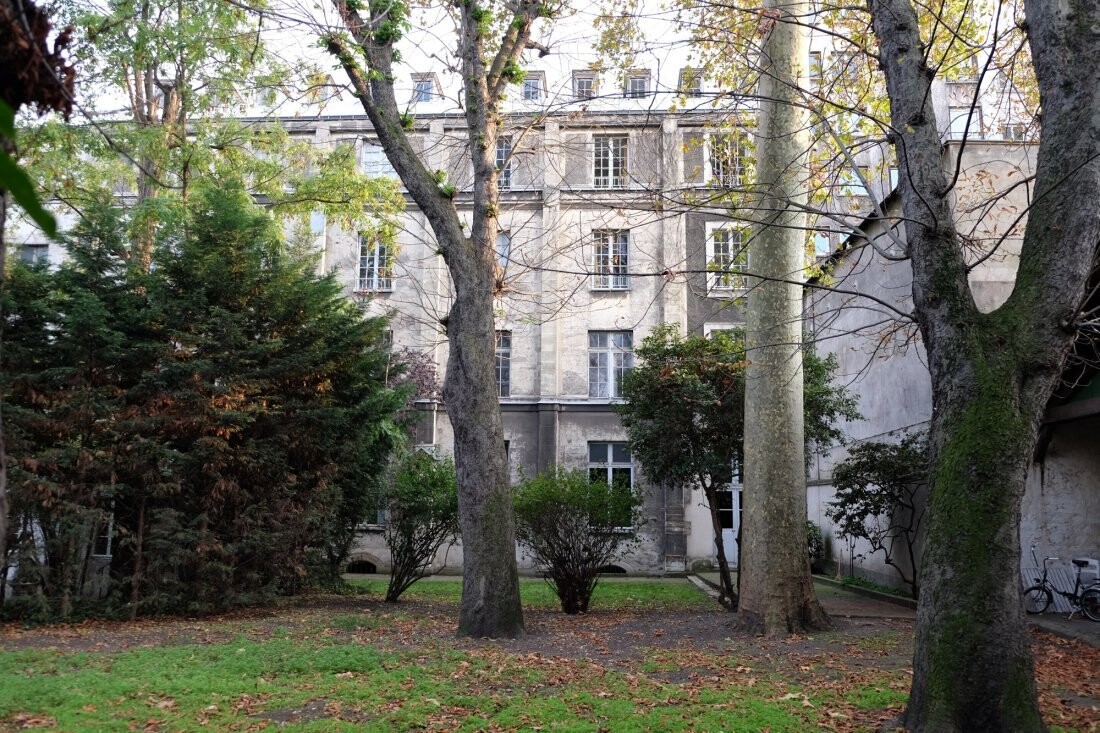The former Visitation Monastery in the 6th arrondissement of Paris has obtained a building permit in 2018 for a shared housing project. Local residents and heritage defenders are strongly opposing the project, which aims to transform the former monastery into shared residences managed by three Catholic associations. The architectural project has sparked heated debates.
The appearance of demolition signs on the facades marked the “last chance” for Julien Lacaze, president of the Sites & Monuments heritage defense association. Lacaze has been following this transformation project for several years. After the community of the Visitation Sisters moved out in the 2010s, the Diocese of Paris acquired this 19th-century monastery with the intention of turning it into a welcoming place, in line with the religious congregation’s wishes. The project, which emerged in 2012, plans to accommodate three associations on this plot of over 7,000 square meters. Based on the concept of supportive co-living, they will welcome pregnant women in difficult situations, people with disabilities, and others facing precarious situations.
A building permit granted by the City of Paris in 2018 was followed by three legal actions from local residents. Among them was actor Gérard Depardieu, whose nearby Hotel Chambon property “will be overshadowed by the mass of the adjacent building,” according to the association that joined the legal action as an interested party. All legal procedures have been dismissed.
“The diocese wants to create a project that is indeed social, but goes against the public interest. The City of Paris is missing out on one of the last opportunities to create a beautiful public garden in an area that lacks green spaces,” criticizes Julien Lacaze, while interior works are currently underway to establish structural diagnostics.
The diocese’s project plans to create a pedestrian pathway open to the public throughout the plot, although not all of the 4,000 square meter garden will be accessible. “An opening will allow the public to walk from Rue de Vaugirard to Rue du Cherche-Midi through a central alleyway, and to connect the area, with a small square transformed into a play area for children,” notes Stéphane Bazin, operational project manager.
“It should be noted that this is private property, entrusted by the religious sisters to the diocese for a project of collective interest. The majority of this garden will first benefit the most vulnerable individuals being accommodated. All the co-living spaces will overlook this area,” he adds.
According to the defenders of the monastery, the successful implementation of the project would lead to irreversible losses, “breaking the functional coherence of the site.” While a mansion, a former girls’ boarding school, and the main chapel will be preserved and renovated, others will not survive the project.
Agricultural buildings, a chicken coop, small oratories in the garden, and functional annexes such as a laundry room or bakery will be sacrificed to make way for new buildings, whose stone facades are considered “architecturally poor” by Julien Lacaze. These buildings will accommodate 43 housing units, as well as a daycare center and two shops.
“The most serious heritage damage is on the side of Rue du Cherche-Midi,” says the president of Sites & Monuments. “There is a small chapel crossed by a former cowshed. It is a unique 19th-century building. On the surrounding wall, two Louis XVI pilasters will also be destroyed.”
The Diocese of Paris asserts that there has been constant consultation with the Old Paris Commission, the architect of historic buildings, and the municipality’s services since the beginning of the project. “In our country, there are administrative authorities that are very strict about heritage preservation. The permission for the building has been refined, it took a lot of time, it was a meticulous and patient work of concentration, and in the end, all the essential historical parts in the eyes of specialists have been preserved,” says Stéphane Bazin.
Regarding the former cowshed, which has not served that purpose for at least 45 years and has been converted into housing, and the other annex buildings, the experts “did not consider them to have any heritage value,” according to Bazin.
For opponents of the project, this historic plot is insufficiently protected. “The City’s Urban Development Plan allows for limiting the height of constructions and protecting private gardens, but it does not prevent their division. However, this garden could be connected with others nearby. We could establish an urban farm there,” proposes the activist, who believes that the City of Paris should use its power of expropriation for the public good in a context of insufficient green spaces. The urban farm project has been the subject of a petition since 2020.
As a last resort, the Sites & Monuments association has filed a request for the placement of the Visitation Monastery. This measure is taken when a building of heritage value is under threat, as defined by the Ministry of Culture. Rarely granted, this exceptional suspension must come from the minister herself. It freezes any development project for a year, allowing the State services time to examine the opportunity for a definitive protective decision, such as listing or classification as a historic monument.
For Julien Lacaze, this is a last-ditch effort, as his initial request in 2018 went unanswered. “We hope that this emblematic dossier, which is of both heritage and environmental importance, will be saved.”
Follow all the news from your favorite cities and media by signing up for Mon Actu.



